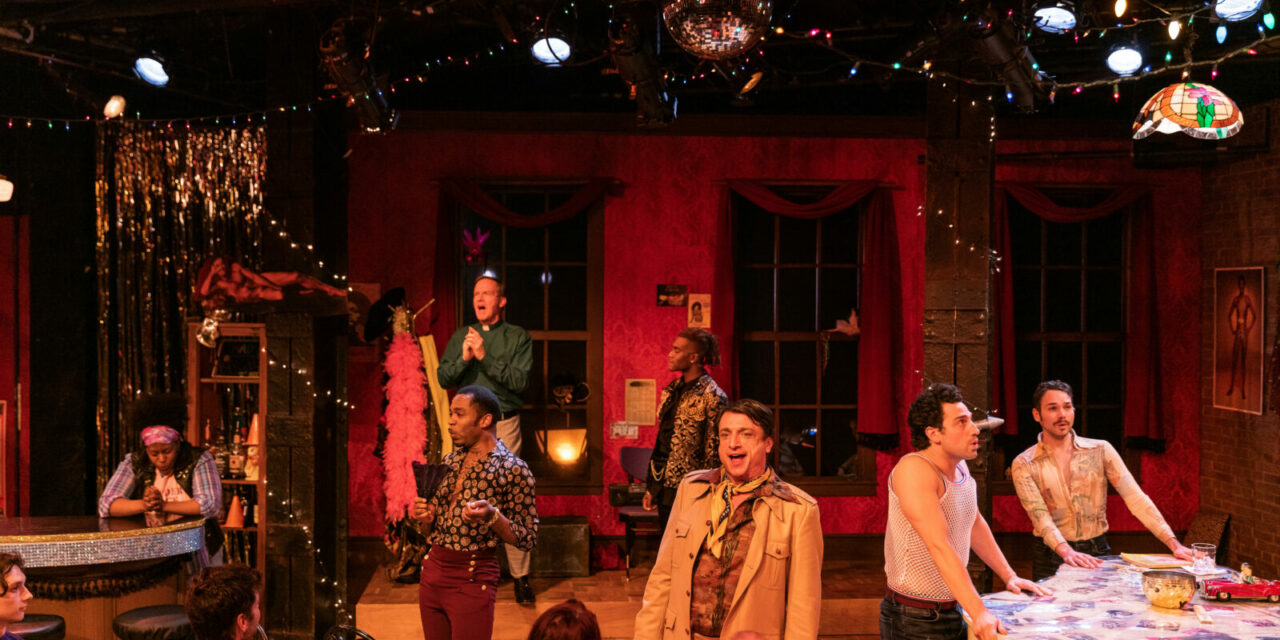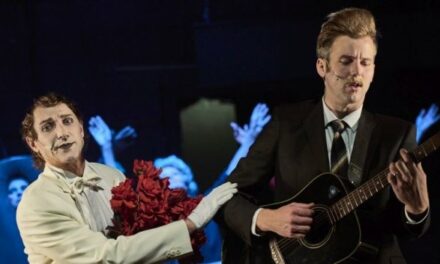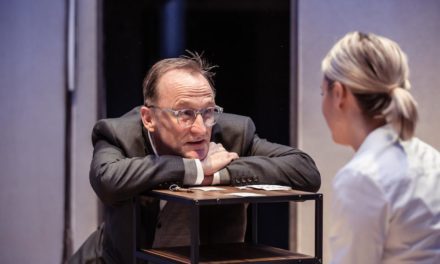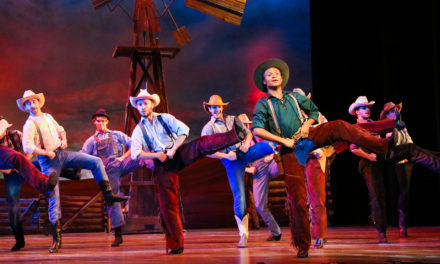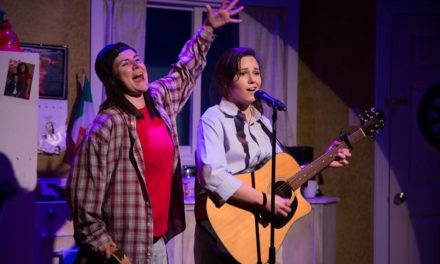Pushing through the colored streamers that shield the doorway of the Plaza Theatre at the Boston Center for the Arts, I marveled as I stepped not into a theater, but a chintzy 1970’s gay dive bar. Posters of celebrities and gay icons inundated the red velvet walls: Judy Garland, Liza Minnelli, a naked Burt Reynolds. A white piano with inexplicably placed, but somehow appropriate, mannequin heads looking up from underneath. A bar near small round tables on a cheap checked floor. And above all of the tchotchke, lights of all shapes and kinds: colorful string lights, chandeliers, hanging lamps, all of them functioning. As audience members settle in, the actors in character enter and mingle. They murmur in conversation, and noodle on the piano. They are laughing, hugging, and kissing. Even before The View Upstairs has officially started, the show has already begun.
The View Upstairs, a new musical by Max Vernon performed Off-Broadway in 2017, now directed by Paul Daigneault for Boston’s SpeakEasy, was inspired by the real-life UpStairs Lounge, a gay bar in New Orleans. In 1973, the bar was firebombed resulting in 32 deaths; it was the worst attack on a gay club until the 2016 Pulse shooting in Orlando. Because of the rampant homophobia of the time, newspapers barely touched the story of UpStairs Lounge fire. Inhuman anecdotes surround the tragedy, such as the Lounge’s patrons throwing their wallets into the fire before dying in order to maintain anonymity, parents refusing to claim their dead children in morgues, and survivors getting fired from their jobs due to their discovered homosexuality. However, even as gay rights improved and LGBT history reclaimed, the story of the UpStairs Lounge lost its place in the narrative of gay struggle in favor of the more widespread 1980s AIDS crisis, Stonewall riots, and now, Pulse nightclub shooting. The tragic bar fire from the 197’s has been largely forgotten.
Max Vernon created The View Upstairs to remember and celebrate not only the UpStairs Lounge itself but as a way to connect the present to pre-AIDS gay past, where closeted folks found acceptance, community, and paradise in safe havens that bars like the UpStairs Lounge offered.
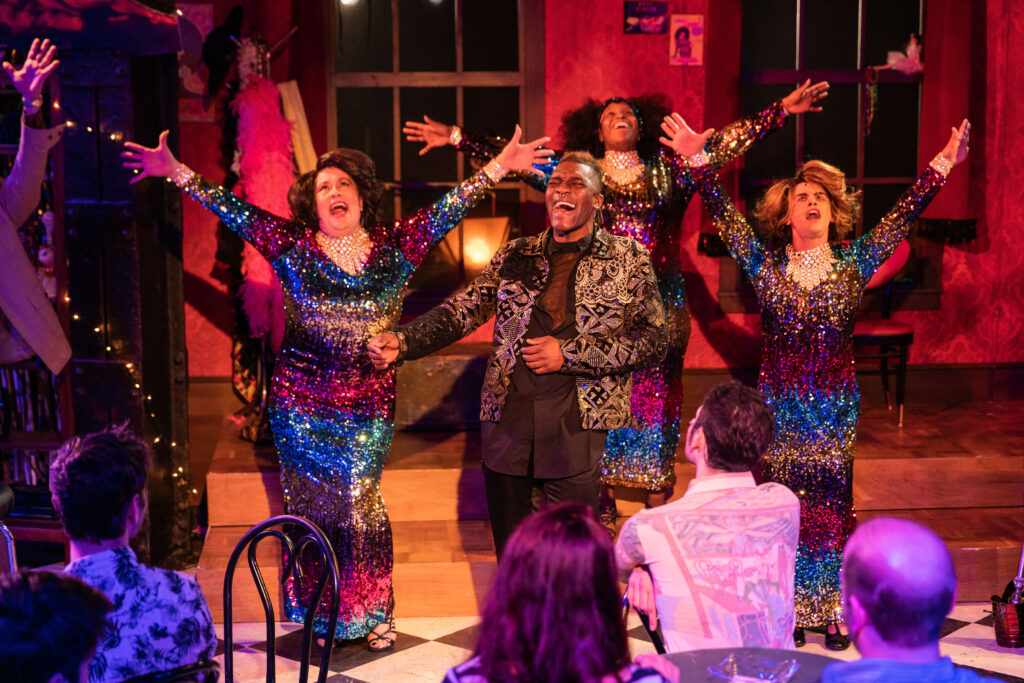
J’Royce Jata and the cast of The View Upstairs. Photo by Nile Scott Studios
In this musical, present-day 20-something social media influencer, Wes, played by J’Royce Jata, has recently bought the long-abandoned UpStairs Lounge. While exploring the desolate place and imagining how he can transform this shell of a bar into something flashy and modern, Wes is suddenly transported to the pre-fire UpStairs Lounge of 1973 and meets the vibrant and diverse regulars that patronize the bar. Buddy, the pianist, played by Will McGarrahan leads the locals in the bar’s ‘theme song;’ most gay bars of the 1970s had their own personal anthem. Richard, the reverend, played by Russell Garett collects money for local hospitals and leads his congregation of friends in gay-friendly sermons. Inez, played by Johanna Carlisle-Zepeda, helps her son Freddy, played by Shawn Verrier, prepare for a drag performance that ultimately climaxes with confetti bursting from a pre-Madonna coned brasserie. The actors—I’ve named only half—embody their characters with such realism and vulnerability that one could imagine the roles written with these actors specifically in mind.
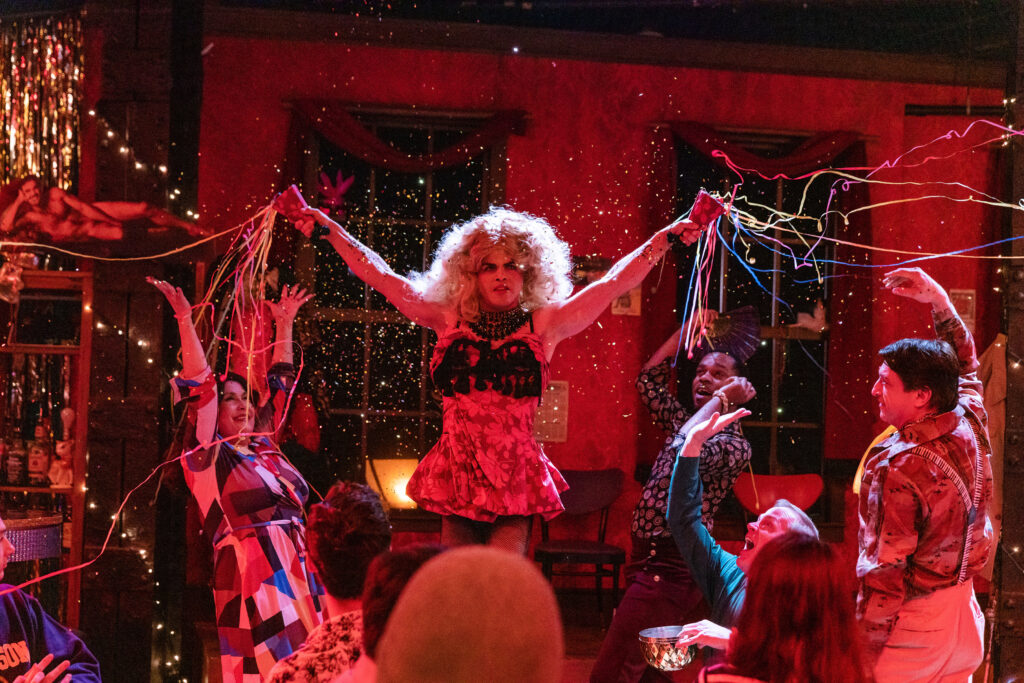
Shawn Verrier and the cast of The View Upstairs. Photo by Nile Scott Studios
Wes learns to respect the sacrifices made by these men so that people like Wes can live more openly and freely. He witnesses a police raid, the aftermath of gay bashing, and of course, the inevitable fire that claimed 32 lives. Wes also sees diverse people coming together, celebration, and connection, forcing him to question his own life that is mostly viewed through a phone screen.
At times, The View Upstairs is quite clunky. Time travel reeks of a plot device. Characters speak to each other in a performative manner that would be more suitable for a sitcom than in the theatre. The actors sing together in gorgeous harmony but struggle on their own—poor sound levels don’t help.
However, I find myself appreciating the flaws of The View Upstairs and if anything, these imperfections support the themes of the everyday community. The haphazard quality reminds me of my own local theatre bar that I used to frequent when living in San Francisco. Yes, the cabaret singers were sometimes off-key and performances were mostly amateur, but the feeling of belonging was infectious. The View Upstairs captures that feeling. I only regret that I saw the show on a Sunday afternoon: this is a show made for weekend nights, a cheap drink or two in hand, with close friends.
This post was written by the author in their personal capacity.The opinions expressed in this article are the author’s own and do not reflect the view of The Theatre Times, their staff or collaborators.
This post was written by Rem Myers.
The views expressed here belong to the author and do not necessarily reflect our views and opinions.

